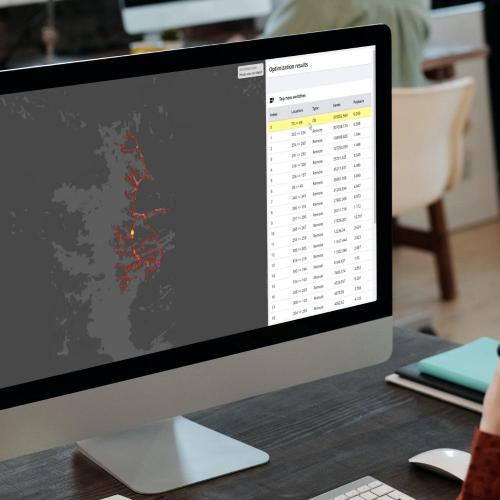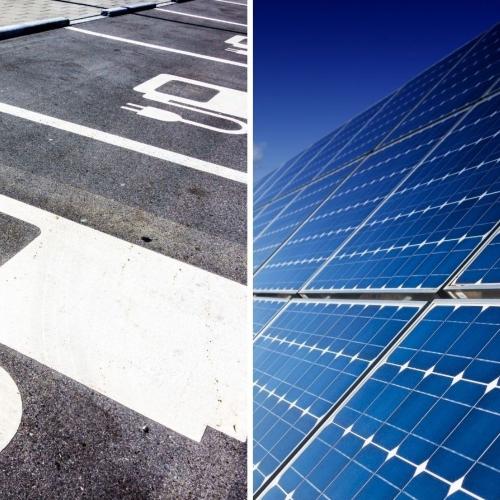Trimble Network Optimizer is a next-generation planning solution whose power lies in the ability to effortlessly evaluate countless scenarios: a planner provides input, and the solution returns the most optimal network in an instant. Why is this revolutionary?
When designing a network, there are always multiple aspects to consider:
- technical quality of distribution
- reliability of distribution
- economic effects.

Want to save on interruption costs by making only small investments in your fault-prone MV network? Interruption costs have a direct impact on the allowed regulatory profit, and investing in switching devices is a very powerful way to influence this. Network Optimizer can find optimal new locations and types for your medium voltage switching devices. The decision on new switching devices will be made on the basis of their impact on reducing interruption costs. The solution is available to utilities as a service (SaaS).
HOW IT WORKS: Network Optimizer can optimize medium voltage switching in terms of location, type, and the state of the switching devices.

Want to balance network loading in normal operation, for example, to reduce losses? By optimizing the states of the existing switches of your MV network, you can find the best possible network switching state for normal operation.
HOW IT WORKS: The user sets a target that can be, for example, the load grades of lines and transformers, or the reduction of losses. Network Optimizer then adjusts the open points in the network.

Want to use your time to create value instead of carrying out repetitive manual tasks when doing contingency planning? By optimizing the states of the existing switches of your MV network, you can find the best possible network switching states to replace an unavailable transformer in contingency.
HOW IT WORKS: The user marks one of the main transformers as out of service and Network Optimizer finds the best possible switching states for the network.

Are you using target networks in your MV network investment planning? Do you know what your optimized target network would look like? If so, is your target network up to date and has it been designed with respect to various possible scenarios, such as increasing penetration of DER, or constructing new primary substations?
With Network Optimizer, your target network stays up-to-date and robust enabling long-sighted investments that cover different scenarios in your utility’s changing operational environment.
HOW IT WORKS: Network Optimizer provides you with an optimized target network that is technically secure and feasible, and minimizes investments, outages, and costs for losses. You can start working towards your target network either when planning a new network or making renovation designs.

Is there a bulk of investments ongoing in your network? Are you struggling with deciding which of the investments should be prioritized to ensure alignment with your utility’s business strategy? With low voltage networks, efficient asset investment management and planning requires sufficiently accurate information on alternative projects. Such plans, if made by contractors, can be costly but still not optimal from the utility’s business perspective. Also, using some rough factors may not provide information accurate enough for prioritization. Network Optimizer beats these challenges by giving accurate information on alternative projects and helping you make the right investment decisions while saving on planning costs, especially when dealing with large investment volumes.
HOW IT WORKS: When doing preliminary planning, Network Optimizer automatically collects material quantities and uses them for certain key figures to compare plans and projects.

Is your utility concerned about handling increasing loads in the form of Electric Vehicles (EV) or increasing amounts of infeed from Distributed Energy Resources (DER)? Have you ever struggled with the question of where exactly to put your renovated distribution substation – or should there be two instead of one?
Low voltage scenario planning is key to tackling these challenges. It enables you to make better, long-sighted investment decisions with less planning effort regardless of the volume of investments.
HOW IT WORKS: For example, add EV or DER, or apply load growth in any specific area. Network Optimizer will provide proposals for future renovations.

|
Finding optimal solutions is particularly challenging when a network design must also take into account the effects of e.g. energy transition and urbanization in the future. The traditional way of designing a network requires manual modeling of any changes to the network (i.e. adding, deleting or changing objects) and the calculation of technical and financial indicators as separate work steps and with separate tools. This is repeated for all possible planning scenarios. In practice, taking into account different variables, evaluating several scenarios and finding good solutions is very laborious and time consuming for the network planner – if not impossible. Also, the resulting network designs may not be comparable, and it becomes difficult to assess the impact of projects. The risks for investment decisions based on incomplete data are very high, and the visibility into the future indicators is inaccurate.
|

What if you started doing network planning from a whole new perspective? Instead of laborious routines, the planner would select objects and click a button. The planning robot would then generate network models, dimension lines and fuses, locate switches, search for routings, and calculate cost impacts. The power of the planning robot lies in its ability to iterate numerous scenarios and form a proposal for an optimal solution in an instant.
This saves time and effort for the planner. The resulting network designs are consistent in quality and investment decisions can be based on facts.

Optimization is performed within customer and case specific requirements and rule sets:
- Electro-technical rules (voltage and ampacity)
- Reliability requirements (backup policies)
- Preferred components and prices (lines and switches)
- LV Assemblies and fuse planning rules
- Routing based on a map.

Trimble Network Optimizer can be used for designing low- and medium-voltage network and their scenario analysis.
Network Optimizer needs surprisingly little data to calculate the optimal network. This means that incomplete network data is not a barrier to using Optimizer. Network data can also be entered into Optimizer manually.
Network Optimizer is very easy to deploy.
Network Optimizer is not just a PSA (a Power System Analysis tool) because Network Optimizer also calculates various cost factors such as construction costs, technical losses and outage costs.
Yes, it does. Network Optimizer deals with both consumption and production when optimizing a network.
Network Optimizer can be used to design a completely new network or to design a network where the existing network is also used as input data. Users can choose from the existing network what they want to keep. Network Optimizer also has tools that help the users determine what to keep.
Network Optimizer supports the designing of both cable and overhead networks.

